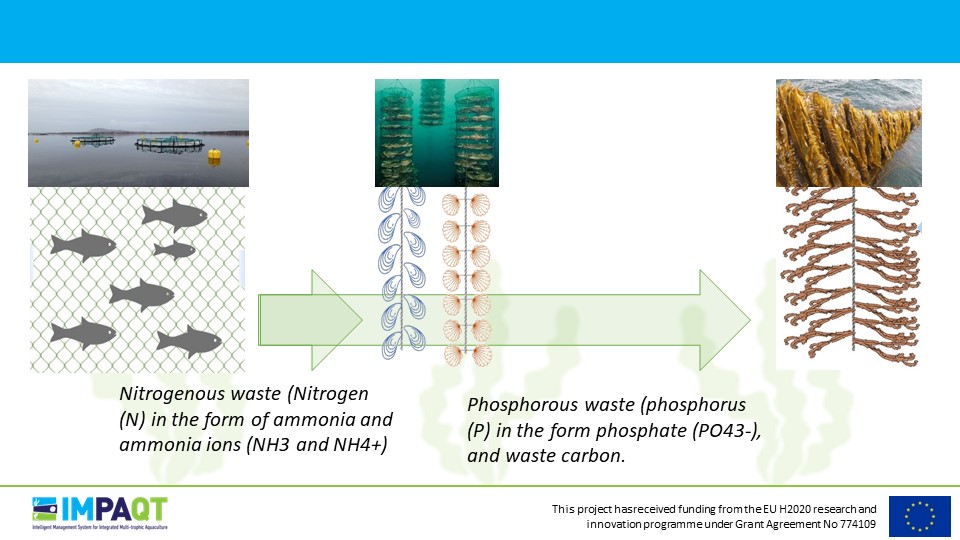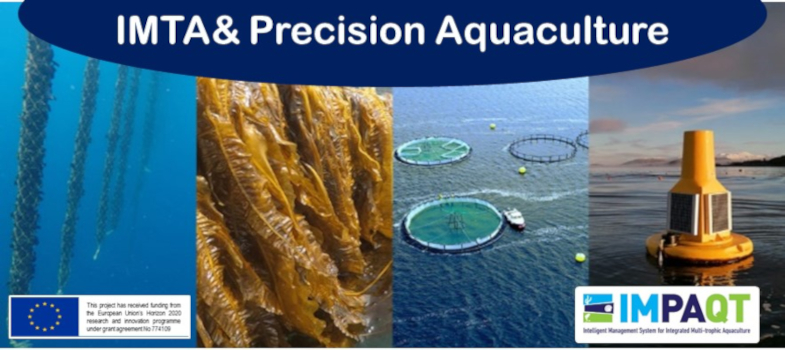Introduction to IMTA
Introduction to IMTA
Integrated multi-trophic aquaculture, or IMTA, is a term to describe a specific concept in aquaculture.
The idea itself is not new, but the acronym was first mentioned in 2003 by Thierry Chopin and was formalised at a workshop in Canada in 2004, where following discussions, he and Jack Taylor agreed on the importance of each of the elements in the term. Therefore, the acronym IMTA, or Integrated Multi-Trophic aquaculture, was agreed.
Chopin has carried out a lot of the seminal works on modern IMTA, presenting a paper at an aquaculture conference in New Brunswick, Canada in 1995, called Mixed, integrated, poly-, or multi-level aquaculture - whatever you call it, it is time to put seaweeds around your cages!. This introduced the concept before there was an agreed name for it. Since then there has been more than 1,500 papers published on the topic, indicating the importance of the concept in modern thinking.
Current aquaculture practises involve growing a single species of animal (or crop) in an area, and this is known as mono-culture. It is currently the primary method used in aquaculture. Adding some additional species to that area would be known as polyculture - growing 2 or more species in the same area.
IMTA is a specific type of polyculture —it required growing 2 or more species—, and those species grown have to be complementary to each other in some way. The species being farmed should derive benefits from the arrangement somehow, and the set-up should be advantageous in general. Growing a number of fed fish species together
is poly-culture, but this does nothing to address the environmental impacts of adding nutrients to the system so would not satisfy the concept of IMTA.
The FAO Aquaculture Glossary defines IMTA as:
IMTA is the practice that combines, in the appropriate proportions, the cultivation of fed aquaculture species (e.g. finfish/shrimp) with organic extractive aquaculture species (e.g. shellfish/herbivorous fish) and inorganic extractive aquaculture species (e.g. seaweed) to create balanced systems for environmental sustainability (biomitigation) economic stability (product diversification and risk reduction) and social acceptability (better management practices).
and defines integrated aquaculture as:
Aquaculture system sharing resources —water, feeds, management, etc.— with other activities; commonly agricultural, agro-industrial, infrastructural (wastewaters, power stations, etc.).
This video gives a very brief outline of IMTA:
In Asia, integrated aquaculture has been widely practised for centuries by small farms. Rice and fish farming is probably one of the oldest, where rice fields provide the environment and habitat for fish and other aquatic animals. Farm animals, such as pigs and ducks, have also been used to fertilise fish ponds in similar complementary arrangements. The fish contribute to nutrient cycling by feeding on invertebrates and other organic particles that are produced in these fields. The principle is that the fish, ducks or pigs provide nutrient inputs to benefit the other species and the plants.
Integrated aquaculture is relatively new in Europe and the western world, which tended to focus on mono-culture in farming practises and have followed a similar path with the development of aquaculture. When we talk about IMTA we have 3 elements: the integrated, the multi-trophic, and the Aquaculture elements:
- The 'Aquaculture' element is the farming of aquatic organisms, as previously discussed.
- The 'Multi-Trophic' element means that the species must come from different levels of the food chain. In a simple food chain, the base of the chain is plants that use sunlight to create energy so that they grow —seaweeds and algae are examples. The animals that feed on these primary producers, such as shellfish, mussels, and oysters, would be the next trophic level up —these grow by eating the primary producers, the plants, or micro-algae. Then the energy passes up the chain as animals eat each other. Fish are higher up the food chain again. This is what we mean by trophic levels. So the Multi-trophic element means that the organisms should come from different trophic levels —at least 2 trophic levels. It should be noted that the food chain in water differs than that on land, in that on land much of the primary productivity —leaves and plants— is not utilised and goes to waste, whereas in aquatic environments the vast bulk of the primary productivity is utilised by organisms further up the food chain.
- The ‘Integrated’ element suggests that the species farmed are linked to each other in some way, serving complementary functions within the ecosystem. This is the key element of successful IMTA; the species from different trophic levels are farmed together in such a way that they are complementary to each other. The idea is that the organic and inorganic waste from one species serves as nutritional inputs for the other species. This waste from one cultured species are reused to serve as nutritional inputs for others, reducing or eliminating the waste as it is now a useful by-product or could be called a co-product.
A typical IMTA set-up might include fed fish farmed in pens, tanks or cages, these fish release waste into the surrounding water. Filter feeders, such as mussels or other bivalves, can be grown adjacent to the pens to use this waste to grow, by filtering out the small particulate organic matter (POM). Seaweed could also be included and these absorb the dissolved inorganic nutrients, or minerals, from the water to grow.
Finally, an invertebrate —such as sea-cucumber, sea urchins or worm—, could be grown on the sea-bed, which would feed on the larger organic waste that falls to the sea-bed, from both the fed fish species and from the
filter feeders. The bacterial component is also a factor but is less studied.
This set-up can be run safely and efficiently together to reduce environmental impacts, to optimise the use of the space, to provide product diversity on the farm, and to provide alternative revenue streams for the farmer.

That describes a fairly typical IMTA set-up but the arrangement can be very diverse. Variations of IMTA include aquaponics of freshwater IMTA, agriculture aquaculture -where the nutrient input comes from agricultural species, biofloc, green water and numerous other variations. There is no one ideal IMTA system, it is a concept that can be applied to specific scenarios.
The most appropriate combination of species depends on a number of factors, such as the site, the environment, the inputs, the water and currents, as well as the economic factors, the social factors, the experience of the farmer, and the regulatory factors. The combination of these factors will lead to different choices in the design of the best suited IMTA system for any specific location.
Ideally, the co-cultured species should be more than just bio-filters - they should also be harvestable crops of economic value. Having a second product is useful as it gives product diversity and creates a second revenue stream, but the value of IMTA is much more than commercial. The ecosystem services provided can be a huge benefit from the system. IMTA reduces the environmental impact; it uses the space more efficiently. This gives a boost to consumer perception of the products, and in the societal and the political license to operate. These are key benefits to the aquaculture sector in general.
Here is a more comprehensive discussion on the concept of IMTA:
https://www.open.edu/openlearncreate/pluginfile.php/589824/mod_page/content/17/Introduction%20to%20IMTA.mp4Video player: Introduction%20to%20IMTA.mp4
